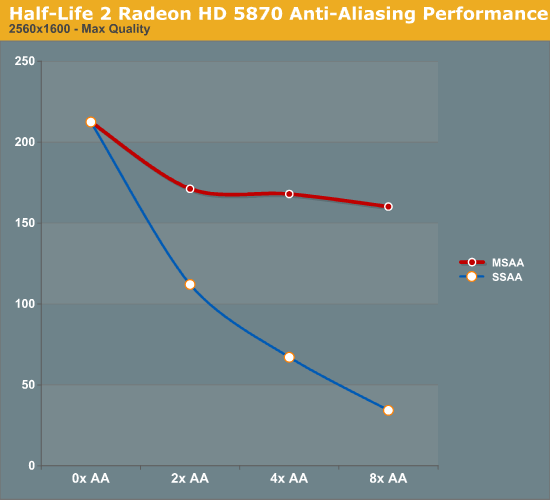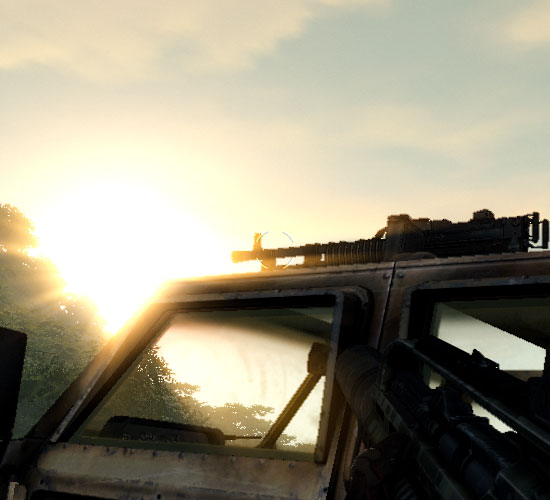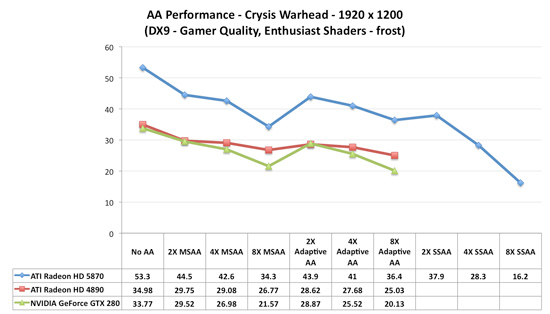AMD's Radeon HD 5870: Bringing About the Next Generation Of GPUs
by Ryan Smith on September 23, 2009 9:00 AM EST- Posted in
- GPUs
AA Image Quality & Performance
With HL2 unsuitable for use in assessing image quality, we will be using Crysis: Warhead for the task. Warhead has a great deal of foliage in parts of the game which creates an immense amount of aliasing, and along with the geometry of local objects forms a good test for anti-aliasing quality. Look in particular at the leaves both to the left and through the windshield, along with aliasing along the frame, windows, and mirror of the vehicle. We’d also like to note that since AMD’s SSAA modes do not work in DX10, this is done in DX9 mode instead.
|
AMD Radeon HD 5870
|
AMD Radeon HD 4870
|
NVIDIA GTX 280
|
| No AA | ||
| 2X MSAA | ||
| 4X MSAA | ||
| 8X MSAA | ||
| 2X MSAA +AAA | 2X MSAA +AAA | 2X MSAA + SSTr |
| 4X MSAA +AAA | 4X MSAA +AAA | 4X MSAA + SSTr |
| 8X MSAA +AAA | 8X MSAA +AAA | 8X MSAA + SSTr |
| 2X SSAA | ||
| 4X SSAA | ||
| 8X SSAA |
From an image quality perspective, very little has changed for AMD compared to the 4890. With MSAA and AAA modes enabled the quality is virtually identical. And while things are not identical when flipping between vendors (for whatever reason the sky brightness differs), the resulting image quality is still basically the same.
For AMD, the downside to this IQ test is that SSAA fails to break away from MSAA + AAA. We’ve previously established that SSAA is a superior (albeit brute force) method of anti-aliasing, but we have been unable to find any scene in any game that succinctly proves it. Shader aliasing should be the biggest difference, but in practice we can’t find any such aliasing in a DX9 game that would be obvious. Nor is Crysis Warhead benefitting from the extra texture sampling here.
From our testing, we’re left with the impression that for a MSAA + AAA (or MSAA + SSTr for NVIDIA) is just as good as SSAA for all practical purposes. Much as with the anisotropic filtering situation we know through technological proof that there is better method, but it just isn’t making a noticeable difference here. If nothing else this is good from a performance standpoint, as MSAA + AAA is not nearly as hard on performance as outright SSAA is. Perhaps SSAA is better suited for older games, particularly those locked at lower resolutions?
For our performance data, we have two cases. We will first look at HL2 on only the 5870, which we ran before realizing the quality problem with Source-engine games. We believe that the performance data is still correct in spite of the visual bug, and while we’re not going to use it as our only data, we will use it as an example of AA performance in an older title.

As a testament to the rendering power of the 5870, even at 2560x1600 and 8x SSAA, we still get a just-playable framerate on HL2. To put things in perspective, with 8x SSAA the game is being rendered at approximately 32MP, well over the size of even the largest possible single-card Eyefinity display.
Our second, larger performance test is Crysis: Warhead. Here we are testing the game on DX9 mode again at a resolution of 1920x1200. Since this is a look at the impact of AA on various architectures, we will limit this test to the 5870, the GTX 280, and the Radeon HD 4890. Our interest here is in performance relative to no anti-aliasing, and whether different architectures lose the same amount of performance or not.
Starting with the 5870, moving from 0x AA to 4x MSAA only incurs a 20% drop in performance, while 8x MSAA increases that drop to 35%, or 80% of the 4x MSAA performance. Interestingly, in spite of the heavy foliage in the scene, Adaptive AA has virtually no performance hit over regular MSAA, coming in at virtually the same results. SSAA is of course the big loser here, quickly dropping to unplayable levels. As we discussed earlier, the quality of SSAA is no better than MSAA + AAA here.
Moving on, we have the 4890. While the overall performance is lower, interestingly enough the drop in performance from MSAA is not quite as much, at only 17% for 4x MSAA and 25% for 8x MSAA. This makes the performance of 8x MSAA relative to 4x MSAA 92%. Once again the performance hit from enabling AAA is miniscule, at roughly 1 FPS.
Finally we have the GTX 280. The drop in performance here is in line with that of the 5870; 20% for 4x MSAA, 36% for 8x MSAA, with 8x MSAA offering 80% of the performance. Even enabling supersample transparency AA only knocks off 1 FPS, just like AAA under the 5870.
What this leaves us with are very curious results. On a percentage basis the 5870 is no better than the GTX 280, which isn’t an irrational thing to see, but it does worse than the 4890. At this point we don’t have a good explanation for the difference; perhaps it’s a product of early drivers or the early BIOS? It’s something that we’ll need to investigate at a later date.
Wrapping things up, as we discussed earlier AMD has been pitching the idea of better 8x MSAA performance in the 5870 compared to the 4800 series due to the extra cache. Although from a practical perspective we’re not sold on the idea that 8x MSAA is a big enough improvement to justify any performance hit, we can put to rest the idea that the 5870 is any better at 8x MSAA than prior cards. At least in Crysis: Warhead, we’re not seeing it.












327 Comments
View All Comments
ClownPuncher - Wednesday, September 23, 2009 - link
Absolutely, I can answer that for you.Those 2 "ports" you see are for aesthetic purposes only, the card has a shroud internally so those 2 ports neither intake nor exhaust any air, hot or otherwise.
Ryan Smith - Wednesday, September 23, 2009 - link
ClownPuncher gets a cookie. This is exactly correct; the actual fan shroud is sealed so that air only goes out the front of the card to go outside of the case. The holes do serve a cooling purpose though; allow airflow to help cool the bits of the card that aren't hooked up to the main cooler; various caps and what have you.SiliconDoc - Wednesday, September 23, 2009 - link
Ok good, now we know.So the problem now moves to the tiny 1/2 exhaust port on the back, did you stick your hand there and see how much that is blowing ? Does it whistle through there ? lol
Same amount of air(or a bit less) in half the exit space... that's going to strain the fan and or/reduce flow, no matter what anyone claims to the contrary.
It sure looks like ATI is doing a big favor to aftermarket cooler vendors.
GhandiInstinct - Wednesday, September 23, 2009 - link
Ryan,Developers arent pushing graphics anymore. Its not economnical, PC game supports is slowing down, everything is console now which is DX9. what purpose does this ATI serve with DX11 and all this other technology that won't even make use of games 2 years from now?
Waste of money..
ClownPuncher - Wednesday, September 23, 2009 - link
Clearly he should stop reviewing computer technology like this because people like you are content with gaming on their Wii and iPhone.This message has been brought to you by Sarcasm.
Griswold - Wednesday, September 23, 2009 - link
So you're echoing what nvidia recently said, when they claimed dx11/gaming on the PC isnt all that (anymore)? I guess nvidia can close shop (at least the gaming relevant part of it) now and focus on GPGPU. Why wait for GT300 as a gamer?Oh right, its gonna be blasting past the 5xxx and suddenly dx11 will be the holy grail again... I see how it is.
SiliconDoc - Wednesday, September 23, 2009 - link
rofl- It's great to see red roosters not crowing and hopping around flapping their wings and screaming nvidia is going down.Don't take any of this personal except the compliments, you're doing a fine job.
It's nice to see you doing my usual job, albiet from the other side, so allow me to compliment your fine perceptions. Sweltering smart.
But, now, let's not forget how ambient occlusion got poo-pooed here and shading in the game was said to be "an irritant" when Nvidia cards rendered it with just driver changes for the hardware. lol
Then of course we heard endless crowing about "tesselation" for ati.
Now it's what, SSAA (rebirthed), and Eyefinity, and we'll hear how great it is for some time to come. Let's not forget the endless screeching about how terrible and useless PhysX is by Nvidia, but boy when "open standards" finally gets "Havok and Ati" cranking away, wow the sky is the limit for in game destruction and water movement and shooting and bouncing, and on and on....
Of course it was "Nvidia's fault" that "open havok" didn't happen.
I'm wondering if 30" top resolution will now be "all there is!" for the next month or two until Nvidia comes out with their next generation - because that was quite a trick switching from top rez 30" DOWN to 1920x when Nvidia put out their 2560x GTX275 driver and it whomped Ati's card at 30" 2560x, but switched places at 1920x, which was then of course "the winning rez" since Ati was stuck there.
I could go on but you're probably fuming already and will just make an insult back so let the spam posting IZ2000 or whatever it's name will be this time handle it.
BTW there's a load of bias in the article and I'll be glad to point it out in another post, but the reason the red rooster rooting is not going beyond any sane notion of "truthful" or even truthiness, is because this 5870 Ati card is already percieved as " EPIC FAIL" !
I cannot imagine this is all Ati has, and if it is they are in deep trouble I believe.
I suspect some further releases with more power soon.
Finally - Wednesday, September 23, 2009 - link
Team Green - full foam ahead!*hands over towel*
There you go. Keep on foaming, I'm all amused :)
araczynski - Wednesday, September 23, 2009 - link
is DirectX11 going to be as worthless as 10? in terms of being used in any meaningful way in a meaningful amount of games?my 2 4850's are still keeping me very happy in my 'ancient' E8500.
curious to see how this compares to whatever nvidia rolls out, probably more of the same, better in some, worse in others, bottom line will be the price.... maybe in a year or two i'll build a new system.
of course by that time these'll be worthless too.
SiliconDoc - Wednesday, September 23, 2009 - link
Well it's certainly going to be less useful than PhysX, which is here said to be worthless, but of course DX11 won't get that kind of dissing, at least not for the next two months or so, before NVidia joins in.Since there's only 1 game "kinda ready" with DX11, I suppose all the hype and heady talk will have to wait until... until... uhh.. the 5870's are actually available and not just listed on the egg and tiger.
Here's something else in the article I found so very heartwarming:
---
" Wrapping things up, one of the last GPGPU projects AMD presented at their press event was a GPU implementation of Bullet Physics, an open source physics simulation library. Although they’ll never admit it, AMD is probably getting tired of being beaten over the head by NVIDIA and PhysX; Bullet Physics is AMD’s proof that they can do physics too. "
---
Unfortunately for this place,one of my friends pointed me to this little expose' that show ATI uses NVIDIA CARDS to develope "Bullet Physics" - ROFLMAO
-
" We have seen a presentation where Nvidia claims that Mr. Erwin Coumans, the creator of Bullet Physics Engine, said that he developed Bullet physics on Geforce cards. The bad thing for ATI is that they are betting on this open standard physics tech as the one that they want to accelerate on their GPUs.
"ATI’s Bullet GPU acceleration via Open CL will work with any compliant drivers, we use NVIDIA Geforce cards for our development and even use code from their OpenCL SDK, they are a great technology partner. “ said Erwin.
This means that Bullet physics is being developed on Nvidia Geforce cards even though ATI is supposed to get driver and hardware acceleration for Bullet Physics."
---
rofl - hahahahahha now that takes the cake!
http://www.fudzilla.com/content/view/15642/34/">http://www.fudzilla.com/content/view/15642/34/
--
Boy do we "hate PhysX" as ati fans, but then again... why not use the nvidia PhysX card to whip up some B Physics, folks I couldn't make this stuff up.